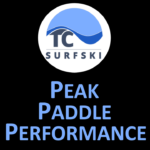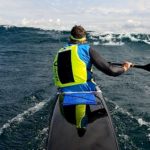A widely held misconception that drives me crazy, is the idea that the waves on the Great Lakes are too “choppy” for downwind surfing. Nothing could be further from the truth. In fact, “choppy” conditions are arguably the best conditions. If we assume that “choppy” means steep, short period waves, those are exactly the conditions in the Columbia River Gorge that everyone loves. Granted, the relatively narrow river and limited fetch in the Gorge keeps the waves clean, but even multi-directional short period steep waves are great for downwind surfing.
Now that I’ve got your attention, what I really want to do with this blog is help set expectations for those paddlers who are relatively new to the sport and might be struggling to find their flow in various downwind conditions.
I still remember the days of being so excited to get out and paddle in the waves, only to quickly become frustrated falling off the back of waves, swamping the cockpit, and getting broached. I promise that those days are not a waste of time and while you may not realize it, you are learning and getting better. As I have progressed, I’ve found that the speed improvements are very gradual, but I’ve become much more consistent in a wide variety of conditions. At this stage I’m confident that as long as the waves are .3 meters or bigger I will be surfing and linking them, regardless of how clean, messy, steep, or stacked they might be. If you want to know what size waves you might be dealing with in your local area check out this website which includes a waves size estimator. Just enter the fetch, wind speed, and duration and you’ll get an estimate of wave size. Of course there are always other factors at play, but I find this to be directionally accurate.
Hero Conditions – Strong Wind Small Waves
The easiest surfing conditions I’ve ever found are where you have 2-6 miles of fetch and wind at 15 mph or greater. The short fetch ensures the waves don’t get that big, while the solid wind gives you a nice boost to easily catch and stay on the waves. It’s a bit counter intuitive, but the rides can be much longer in these small 1-2 foot conditions than they are in bigger 4-6 foot conditions. Add some current, and it’s even better. Opposing current slows down the waves and stacks them up (Columbia River Gorge) and assisting current pushes you onto the wave, holds you on the wave, and generally speeds everything up for record times (Tarifa).
As a beginner, these are the conditions you want to seek out. Easier said than done, but I strongly encourage you to fire up Google Maps and find out where you might find these conditions. Where I’m located in Northern Michigan, I find these conditions on a South wind, on West Grand Traverse Bay. The below footage shows these conditions. On this day I was averaging a bit over 9 mph with very limited effort (Zone 2 for those who track HR zones). The beauty of these conditions is that while you may not hit the big top speeds, you also rarely slow down, so the speed curve is much flatter, hence higher average speeds.
Note: click the gear icon in the lower right to increase the video quality
More Fetch / Less Wind
My primary paddling location typically has 20-60 miles of fetch. On the plus side, it doesn’t take much wind to get surfable waves, but that also means there are many days without a lot of wind assist, and it takes power and timing to catch and link the runs. The conditions show below are a recent December day where the wind had been blowing around 15-18 mph for a few hours, and had died down to around 11-13 mph when I went out. The waves were coming from the SW, so they were getting shaped by a point to the south making them cleaner than direct on-shore waves. The wave size was around 2-4 foot. I was able to get some fast splits averaging close to 10 mph in these conditions, but it took a lot of effort. On the downwind splits I was working at close to 90% of my heart rate max.
15 mph + On-Shore Wind with Lots of Fetch
When the wind comes out of the North at my local spot, there is about 60 miles of fetch. If it blows 15 mph or more consistently for any length of time, the wind waves build to 3+ foot quickly. Because of the on-shore nature and the long and wide fetch, the conditions are often very confused. These are very challenging conditions for a beginner and it will be frustrating and likely slow. But if you persevere, you will get better and over time you’ll come to love these conditions.
On these days the hardest part is wanting so badly to catch the big waves and trying to hard to chase them, while ignoring the smaller easier opportunities. But it is the small waves that will ultimately lead you onto the big ones. Brute force effort might get you there, but it isn’t sustainable. For reasons I can’t articulate, when you brute force your way onto a run, it always ends short and leaves you out of sync with the rhythm of the waves and then you start the whole cycle over again. Better to be patient, get some boat speed by catching the easiest waves you can and work your way up to the big ones.
If you aren’t stable in your boat, you’ll never do well in these bigger messy on-shore conditions. The multidirectional wave action means you have to be ready to change heading at any second and you are often catching waves from an angle. You have to be able to brace equally well on both sides of the boat
As you can see in the video below, the bigger the conditions, the bigger the swings in speed. You’ll hit some great top speeds, but when you’re not linking runs you’ll slow down a lot more than in smaller conditions.
Boat Length and Wave Size
There is a lot of discussion around shorter boats being better at surfing in steep and short period waves. Logically it makes sense, but I haven’t found this to be the case in my experience. I paddle an Epic Gen 3 V12 for half the year and a V9 for the other half. They are quite different boats for sure, but I don’t find that the V9 surfs smaller stuff better than the V12. I would guess that the increased rocker of all the latest generation boats makes a foot or two of length difference a non issue. It is important that if you are in conditions that are right at the threshold of being surfable, you need to surf across the waves. Going perpendicular you will certainly get “stuck” in the waves.
Summary
I wrote a blog a while ago that suggested a formula for dividing wind strength by wave height. The higher the number, the more beginner friendly the conditions. There are always nuances and caveats, but at the end of the day, I firmly believe this formula holds true. I also believe that any wave over 1 foot, should be surfable and 2-3 foot waves will likely be the fastest conditions for most paddlers. Broadly speaking, these are the conditions that are often referred to as “choppy”.
My downwind experience is almost all surfski based, but I believe these same principles apply to SUP, SUP Foiling, and Outrigger.
Bring on the Chop!


